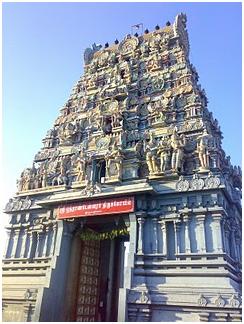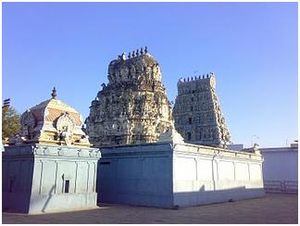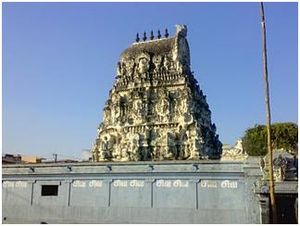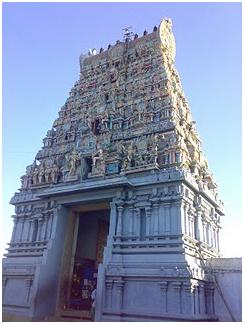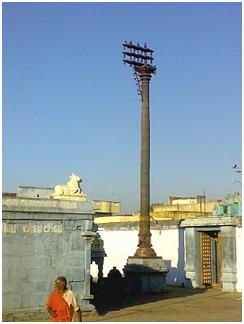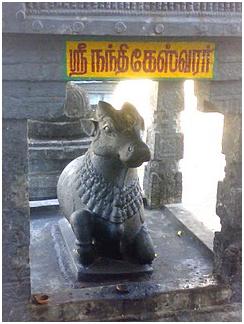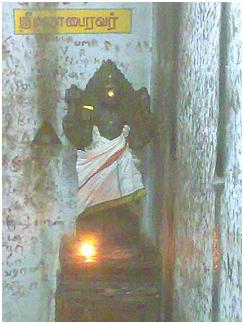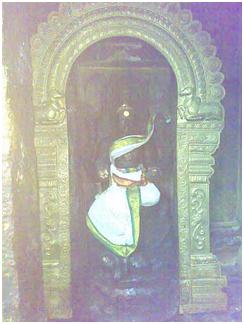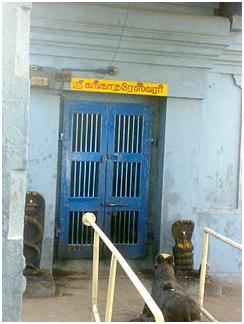Thirumazhisai Sri Othaandeswarar
Thirumazhisai is situated about 25 kms west of Chennai. It can be reached on the road to Thiruvallur from Poonamallee. Thirumazhisai is one out of 3 places where Sage Agasthiyar worshipped Lord Shiva under Azhinjal tree. The Lord here is called in many names: Agatheeswarar, Othandeeswarar, Manaanukooleswarar and Kai Thandha Piraan. Goddess here is Sri Kulirndha Naayagi or Sri Seethalambigai.
As this place was full of Azhinjal trees, it was called as Azhisai in olden days. Later, after God took abode here, the word ‘Thiru’ was added to it and came to be known as ‘Thiru Azhisai’, which later corrupted to become ‘Thirumazhisai’. During the Shiva Parvathi wedding ceremony at Kailash, all the Devas, Gods, Rishis and Ganas gathered to witness the holy event. As everyone gathered at the North, that is Kailash, the whole earth tilted to one side towards North, because of the weight. To balance the Bhoomi, Lord Shiva directed Sage Agasthiyar to go to the southern part of the country. As Sage Agasthiyar felt sad that he would miss seeing the holy wedding of Lord Shiva and Parvathi, Lord Shiva granted him a boon that, from wherever Agasthiyar worships Him, he would get the dharshan of God’s complete wedding ceremony.
While traveling in Southern region, Sage Agasthiyar worshipped Lord Shiva at Velankaadu (today’s Thiruverkaadu), where he wished to see Sri Shiva Parvathi wedding ceremony. The Lord too gave dharshan of the whole wedding ceremony to Agasthiyar there. On realizing this, Pulasthiyar, who is the primary disciple of Agasthiyar and all other disciples, requested Agasthiyar that they too wish to see the wedding of the Lord. Sage Agasthiyar along with his disciples came walking towards south ofThiruverkaadu and stayed in this place, which was a forest filled with Azhinjal trees. As Azhinjal tree is considered most sacred, Sage Agasthiyar installed a Shiva Lingam and worshipped Lord Shiva here. God, pleased with Agasthiyar’s prayers again gave dharshan of His wedding ceremony to Agasthiyar and all his disciples.
Sage Agasthiyar overwhelmed by the mercy of the God, requested God to take abode in this place in Kalyaana Kolam (posture as just wed couple). As wished by Agasthiyar, Lord Shiva and Parvathi took abode here as Uma Maheshwara just behind the Shiva Lingam, worshipped by Agasthiyar. There are 3 places of then ‘Thondai Mandalam’, where Sage Agasthiyar had worshipped Lord Shiva under Azhinjal tree. They are Azhisoor near Kanchipuram, Thirumazhisai near Poonamallee and Chinnakkaavanamnear Ponneri. The divine coincidence is all the 3 temples lie on a straight line.
As centuries rolled by, the place again became a dense forest. An ancient Chozha king called Karikaal Chozha was ruling this Thondai Naadu having Kanchipuram as his capital. He was troubled by people called Kurumbars near his frontier. He was passing through this forest on his elephant for a battle against them. While crossing this forest, he found that his elephant got couldn’t move further as some wild creeper encircled its leg. The king got down from the elephant, took his sword and whipped to cut the creepers off.
He was shocked to find blood oozing out from the place where he hit the sword. He found the beautiful Shiva Lingam, which was earlier worshipped by Agasthiyar at this place. Realizing the sin committed by him by slashing on the Lord’s idol itself, he immediately took his sword and cut his arm. The Lord was pleased by the devotion of the king and made him get his arm back to normal. The king after winning the battle against his enemies came back here and built this temple for Lord Siva. Since, the Lord gave back the hands to the king the deity got the name 'Kai Thandha Piraan' (கை தந்த பிரான்- in Thamizh means 'God, who gave hands').
According to some inscriptions, it is said that this temple had been renovated later by Chozha Kings during 10th century. The sanctum is built in Gajabrishta or Thoongaanai Maadam (தூங்கானை மாடம்) shape, looking like the back of the sleeping elephant, which is seen in many of the temples built in Thondai Naadu, by Chozha kings. Lord Ganesha gives dharshan here as Devaraja Ganapathi facing the main entrance. The main deity (Shiva Lingam) is facing east here, behind which Lord Shiva and Parvathi are seen here in Kalyaana Kolam, blessing the devotees. Many devotees come here and worship the Lord, praying for their sooner marriage.
Beautifully sculpted Dwarapaalakas are seen on either side of the sanctum, guarding the Lord. The temple has a very vast outer Praakaaram with huge Dwajasthambha near which Sri Nandhigeswarar is facing the Lord. The Goddess Sri Kulirndha Naayagi is facing South holding Angusam and Paasam (weapons) on hand and showing Abhaya Hastham, blessing the devotees. Sri Maha Bhairavar is present north east to Sri Ambaal and is facing south. Other deities are Sri Dhakshinamurthy, Naalvar, Lord Brahma and Sri Durga in the Praakaaram.
In the outer Praakaaram, there is another shrine for Lord Shiva called Sri Gangadareswarar. It is believed that Sri Gangadareswarar was installed and worshipped by Sage Pulasthiyar, who was the disciple of Agasthiyar. The Goddess for this shrine is Sri Parvatha Vardhini. There is a separate shrine for Lord Saneeswarar, facing west, at the north east corner of this temple. There is a well nearby, from which the water is used for Abishegams to the deities. This is called Kalyaana Theertham. Originally Azhinjal tree was the Sthala Viruksham for this temple. But, as Azhinjal trees are not found here at present, Vilvam and Paarijaatham are considered Sthala Virukshams for this temple.
There is a very huge and beautiful temple pond on the eastern side of the temple. This pond is called Agasthiya Theertham.
Pournami, Amavasai, Pradhosham and Sivarathri festivals are celebrated well in this ancient temple.

